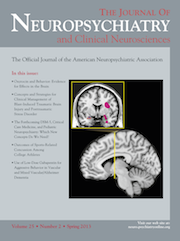Folie à Deux and Anorexia Nervosa: A Case Report
To the Editor: Folie à deux is a rare delusional disorder shared by two people with close emotional ties.1 In the Diagnostic and Statistical Manual of Mental Disorders, 4th Edition, it is classified as Shared Psychotic Disorder (SPD), which is defined as “the transfer of delusional ideas and/or abnormal behavior from one person to another or one person to several others, related or unrelated, who have been in close association with the primary affected person.”2
Anorexia nervosa (AN) is a severe eating disorder characterized by intense fear of gaining weight, a refusal to maintain body weight above 85% of the expected weight for a given age and height, three consecutive missed menstrual periods, and either refusal to admit the seriousness of the weight loss, undue influence of shape or weight on one's self-image, or a disturbed experience in one's shape or weight.2 We are reporting a case of 15-year-old girl who had a shared paranoid delusion with her mother against her father; this shared delusion was contributing to the psychopathology of AN.
Case Report
A 15-year-old girl was transferred from the pediatric medical floor to the Child and Adolescent Psychiatry Unit for management of AN. She had lost significant weight (about 33 lbs) during the last 6 months. She had a fear of gaining weight; she was doing excessive exercise and had amenorrhea for the last 2 years. She denied self-induced vomiting and misuse of laxative or diuretics. The physical examination was unremarkable. Her BMI was 13.28. The laboratory results, including TSH, vitamin B1, and B12, were within normal limits, except for low pre-albumin: 13.8 L (normal range: 18–35.7 L).
During the initial treatment phase, she was observed dividing her meal into small pieces and eating very slowly. She complained about feeling nauseous before meals and about abdominal cramps after meals. During this phase, her mother visited twice per day and requested to bring special food—mainly, extra-virgin olive oil and bread from a special bakery. During individual therapy, she described difficulties with her father. Her mother told her that her younger brother had died because her father put “malignant cancer” in his head. She reported emotional and verbal abuse by her father, who called her “fatty,” and described father as a very controlling person, who controls everything at home, including food. They have a hard time finding food at home; she was trying to save food for her younger siblings. She found it difficult to eat in his presence.
During the family session, her father reported having had a good relationship with the patient in the past. He gave evidence of the delusional belief initiating with her mother and noted how the mother and patient both shared the same belief. Over the course of family therapy, the delusional belief of the mother was clearly apparent. Her mother brought recorded audio cassettes to prove the father wrong. We reviewed the recorded audiocassettes with the mother; who tried to explain hidden meanings of conversations. After the family sessions, she tried to withdraw the patient from the hospital and accused the hospital of providing an unhealthy diet for the patient. We verified the information provided by the father by contacting social services and pediatrician. It appeared that the mother was the primary source of paranoid delusion and was inducing them in the patient. Her shared delusions indirectly were contributing to her eating problem. Whenever she stayed with her grandparents, during vacation time, she usually gained some weight.
Her psychiatric treatment included nutritional rehabilitation, monitoring eating-disorder behaviors, and psychotherapy. We recommended a psychiatric evaluation of her mother. Lately, her mother’s visitations had been limited to twice per week, and all visitations were supervised. Her delusional beliefs had weakened during the hospital stay. After 5 weeks, her care was stepped down to an adolescent eating-disorder partial program.
Discussion
This case illustrates a case of folie à deux involving a mother and daughter in whom a shared delusion was contributing to the psychopathology of AN in the daughter. With temporary separation, the delusional belief of the daughter decreased in intensity. Various case reports on AN in monozygotic and dizygotic twins have been published.3 A clear mechanism for development of AN in the family is unknown. Most acceptable theories are genetic theory in twins and induction theories between family members.4 This case is unique to earlier reported case reports on shared delusions, which were related to either eating disorder or paranoia; in our patient, shared paranoid delusions were indirectly exacerbating the AN of the daughter.
In the literature, shared delusions among all family members of the family has been reported.5 The psychological process of progressing delusional symptoms among family members has been hypothesized as family attempt to preserve the integrity of the family in the presence of a perceived hostile environment.6 This case demonstrates the complexity of AN, SPD, and psychosocial impairments caused by shared delusions. Proper recognition of a rare disorder like folie à deux is very essential for successful treatment. In addition to behavioral and psychopharmacological treatment; separation of the patient from the primary affected person is also therapeutic.
1 : Shared psychotic disorder: a critical review of the literature. Can J Psychiatry 1995; 40:389–395Crossref, Medline, Google Scholar
2
3 : Anorexia nervosa in twins: case report and review. J Clin Psychiatry 1983; 44:101–105Medline, Google Scholar
4 : Anorexia nervosa: a psychiatric investigation of 94 female patients. Acta Psychiatr Scand Suppl 1970; 214:1–194Medline, Google Scholar
5 : Folie a famille. Indian J Psychiatry 2010; 52:69–70Crossref, Medline, Google Scholar
6 : The delusional parent: family and multisystemic issues. Can J Psychiatry 1997; 42:617–622Crossref, Medline, Google Scholar



